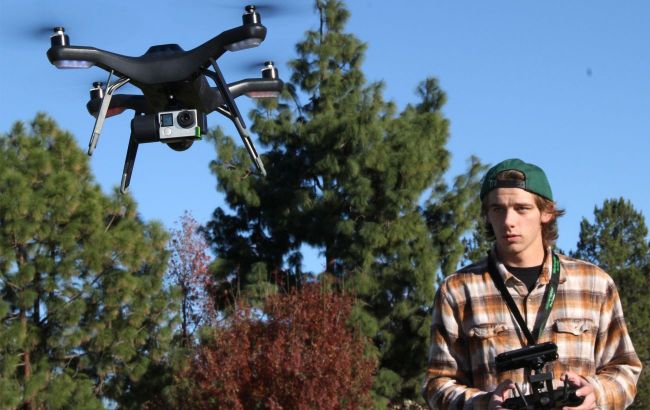TikTok and drones: Why US bans Chinese tech and how Ukraine's caught in the middle
 Illustrative photo: Man with a drone (Getty Images)
Illustrative photo: Man with a drone (Getty Images)
The United States is actively working to counter the growing influence of Chinese tech giants, from TikTok to Temu and Huawei.
RBC-Ukraine analyzes what risks the US government sees in Chinese technologies and why stopping their global expansion isn't always easy.
Key questions:
-
Why does the US want to buy TikTok?
-
Which Chinese technologies is the US trying to ban?
-
What does this mean for Ukraine and other US allies?
Battle over TikTok
The US is in the final stages of negotiations for the sale of Chinese-owned TikTok to American buyers. US officials are concerned that TikTok's parent company, ByteDance, could jeopardize the personal data of American users.
Congress passed a law requiring ByteDance to sell TikTok to a non-Chinese company by January 19, 2025, or face a national ban.
On January 18, TikTok and other ByteDance apps briefly stopped functioning in the US. However, newly elected President Donald Trump delayed the ban multiple times. Interestingly, Trump's campaign team actively used TikTok during the elections.
ByteDance now plans to launch a US-only version of TikTok with separate algorithms and data systems. According to Reuters, this new app will be operated independently and owned by a joint venture of American investors like Oracle, Blackstone, and Andreessen Horowitz, while ByteDance would retain a minority stake.
Outside the US, TikTok will remain under ByteDance's control.
A key unresolved issue: Will US investors gain access to TikTok's proprietary video-recommendation algorithm? Built on complex machine-learning models that analyze geolocation, device type, hashtags, sounds, and user behavior, this algorithm is seen as one of the most powerful in the social media space and central to TikTok's monetization success.
That’s also why US officials fear it could be used to manipulate public opinion.
Beyond TikTok: From telecom to drones
The US has also cracked down on Huawei and ZTE, makers of smartphones and telecom equipment. In 2019, Huawei was added to the US Entity List over espionage concerns, banning it from using US tech. In 2022, the sale of Huawei and ZTE telecom equipment was fully banned.
US officials worry their equipment might contain backdoors allowing Chinese government access to American data. Both companies are believed to have close ties with the Chinese government, and Chinese law (notably the 2017 National Intelligence Law) requires firms to cooperate with state security services.
However, critics argue the bans are partly economic, as Huawei's cheaper products undercut US and European competitors.
The e-commerce platform Temu, owned by PDD Holdings, has also raised alarms over data access, ranging from geolocation to biometric data.
Temu exploited the de minimis rule, which allowed tax-free imports under $800 with minimal inspections. This helped it offer ultra-low prices, challenging platforms like Amazon, eBay, and Etsy.
But that loophole was recently closed. In January 2025, President Trump signed an executive order introducing a 10% tariff on Chinese goods and revoking de minimis for China. Temu prices soared by 130–150%, and though not banned, the platform lost ground to American rivals.
Also, the US is trying to fight back against the expansion of DJI, the world's top drone maker. Its drones (including the Mavic series popular in Ukraine) are widely used in the US for law enforcement, rescue, agriculture, and infrastructure due to their affordability and reliability. But the US suspects DJI may be transferring sensitive data to China, posing a risk to critical infrastructure.
Congress passed a National Defense Authorization Act requiring a DJI security audit by December 23, 2025. If the audit isn't completed, new DJI sales will be banned. However, the audit hasn't yet started.
Additionally, the proposed Drones for America Act would phase out Chinese drones by 2028 and offer grants to US manufacturers.
Pressure on allies
The US is also pressuring allies to limit their use of Chinese tech, using both carrots and sticks.
In 2020, the US warned that countries using Huawei gear could be cut off from intelligence sharing under the Five Eyes alliance (US, UK, Canada, Australia, New Zealand).
That same year, Washington launched the Clean Network initiative to remove Chinese tech (Huawei, ZTE, TikTok, WeChat, etc.) from telecom networks and cloud systems across partner countries. Over 60 nations joined, including NATO members, Japan, and South Korea.
While many formally agreed, actual implementation varies. The UK, Canada, Australia, and New Zealand are the most proactive. In some countries, bans are mostly symbolic. Chinese technologies remain competitive, especially in cost and scalability. For example, some countries only banned Chinese apps from government-issued devices.
This concerns Ukraine as well. The US has repeatedly urged Ukraine to reduce reliance on Huawei telecom equipment. During a 2019 visit, US Secretary of State Mike Pompeo raised concerns over mobile network security. Although Ukraine hasn't imposed a full ban, local operators have started working with Nokia and Ericsson to upgrade infrastructure.
US efforts are gradually leading to the emergence of two global tech blocs: one based on American systems, the other on Chinese. While most countries still have room to maneuver, that space is shrinking. Probably the next major battleground would be artificial intelligence.
Sources: Politico, Bloomberg, Center for Strategic and International Studies, South China Morning Post.

